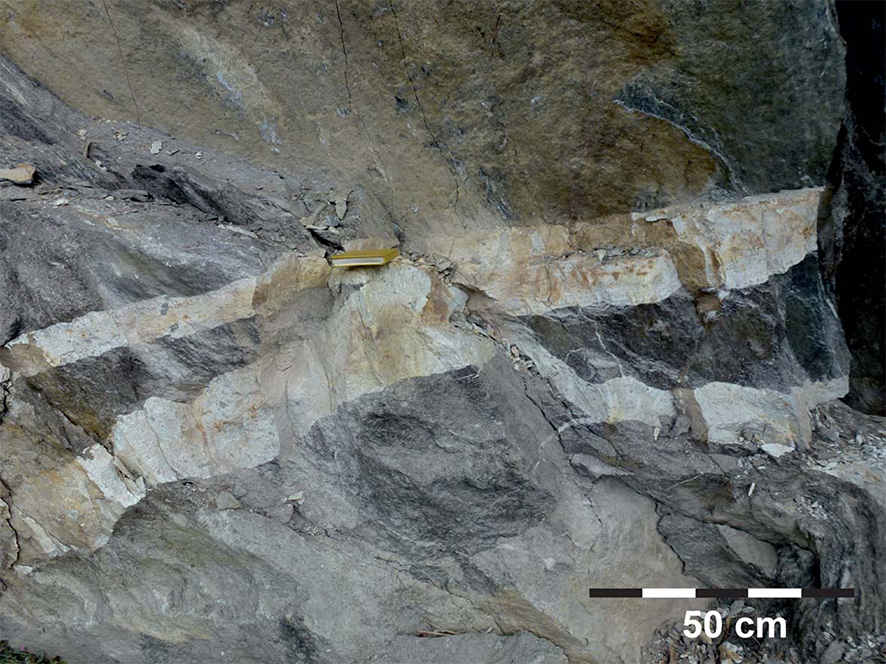3 Main Central thrust
The Main Central thrust (MCT) is a major structure in the Himalayan orogen that has accommodated a substantial amount of the India-Asia convergence (Gansser, 1964; Schelling and Arita 1991). The MCT plays a pivotal role in tectonic models such as channel flow (Beaumont et al. 2001) and wedge extrusion (Kohn 2008). Despite its importance in understanding of geological processes in the Himalayas, its location is in dispute in many transects (Searle et al. 2008) and poorly known in some areas. The MCT is one of the most controversial structures in the Himalaya, due to the divergent criteria used to define the thrust, differences in the methods and approaches of those who study it, and variations in the thrust along the length of the Himalaya.
The MCT separates the Greater Himalayan sequence (GHS) in the hanging wall from the Lesser Himalayan sequence (LHS) in the footwall. Along the entire orogen the MCT is a ductile shear zone, where the precise location is often unclear due to the diffuse nature of the deformation. As there is a difference in the provenance of the rocks either side of the MCT, many recent studies, working in areas where the geological criteria are ambiguous, have used geochemistry as a complementary tool to identify and investigate the tectono-stratigraphic break across the MCT. It has been shown that the LHS is a Palaeoproterozoic sequence with an εNd(0) signature of -20 to - 25, which has been intruded by ca. 1.8 Ga granites, whereas the GHS is a younger, Neoproterozoic-Ediacaran (and possibly Palaeozoic) sequence, characterised by an εNd(0) signature of -15 to -20 indicative of younger source regions, typically intruded by younger, Cambro-Ordovician and subordinate Neoproterozoic (ca. 830 Ma) granites. It is therefore possible to use isotope geochemistry to find the protolith boundary between the LHS and GHS where structural criteria are unclear (Parrish and Hodges 1996; Ahmad et al. 2000; Robinson et al. 2001; Martin et al. 2005; Richards et al. 2005; Richards et al. 2006; Imayama and Arita 2008; Tobgay et al. 2010; Gehrels et al. 2011; Long et al. 2011a; Martin et al. 2011; McQuarrie et al. 2013; Webb et al. 2013).
Sikkim presents an ideal location to studying the Main Central Thrust due to the nearly-unique exposure of the MCT. The thrust has been folded due to a duplex in the LHS rocks beneath the Ramgarh thrust (Bhattacharyya and Mitra, 2009), forming the Tista dome and one of the largest re-entrants of the MCT in the Himalaya (Fig. 1.1). In the Sikkim Himalaya, the MCT separates the Greater Himalayan Sequence, which comprises gneisses, migmatites, calc-silicates and leucogranites, from the greenschist- facies Lesser Himalayan sequence metasedimentary rocks. The transition between these two lithotectonic units forms a several kilometre thick zone of inverted Barrovian metamorphism (Mohan et al., 1989) and penetrative ductile shear. This has often led authors to refer to the MCT as the Main Central Thrust Zone [MCTZ] (Goswami 2005; Gupta et al. 2010), with two bounding thrusts either side of this shear zone (Catlos et al. 2004; Dubey et al., 2005; Bhattacharyya and Mitra 2009; 2011). This zone consists of pelitic schist, psammite, quartzite, calc-silicate and orthogneiss (locally known as the Lingtse gneiss; Paul et al., 1982), which range from chlorite- to sillimanite-grade metamorphism. Recent work in Sikkim has demonstrated that what has traditionally been mapped as the ‘MCT zone’ is primarily comprised of Lesser Himalayan provenance rocks, with the MCT protolith boundary located at the top of this zone (Fig. 1.1). The ductile shear associated with the MCT has penetrated down from this protolith boundary into the underlying LHS rocks in a zone of distributed strain. In detail there is a section of imbricated rock in the immediate vicinity of the MCT where rocks of GHS and LHS provenance have become interleaved during ductile thrusting (Fig. 3.1, Mottram et al., 2014).
Figure 3.1. Map of Main Central thrust and Greater Himalayan sequence localities
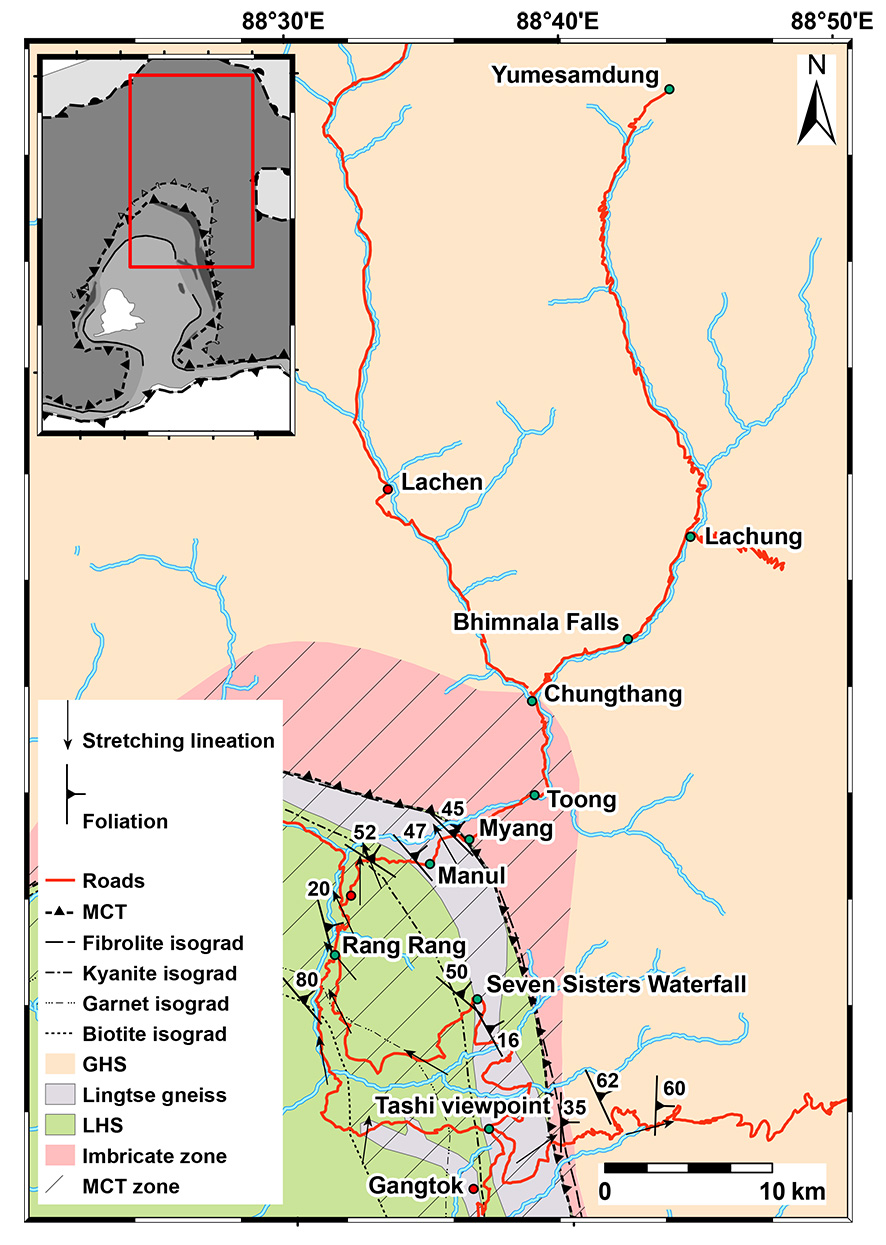
Map of Main Central thrust and Greater Himalayan sequence localities in the Gangtok-Mangan section, inset shows location of section in NE of Sikkim. The upper boundary of the MCT high strain zone is positioned at the protolith boundary of Mottram et al. (2014). Metamorphic isograds are shown as dotted and dashed lines. The extent of the zone of deformation associated with the MCT is shown as the hatched zone
Due to the nature of the diffuse deformation associated with the MCT, it is not possible to see its characteristic features in a single rock outcrop. The MCT is best viewed in a transect across the zone of ductile deformation formed during thrusting along the MCT. This virtual fieldtrip focuses on a road section through the MCT from Gangtok to Chungthang (Fig. 3.1; Table 3.1). This section cuts through an excellent example of an inverted Barrovian metamorphic sequence. The map indicates that as the road travels north from Gangtok to Chungthang, it passes through what is geochemically defined as the Lesser Himalayan Series, ultimately into the Greater Himalayan Series. Towards the top of the zone of deformation there is geochemical evidence for tectonic interleaving in the immediate vicinity of the zone, where a slice of LHS material has been interleaved into GHS rocks (Mottram et al., 2014).
Table 3.1. Virtual field trip stops for Main Central thrust and Greater Himalayan sequence
| Locality | Lat | Long | Description | |
|---|---|---|---|---|
| 3.1 | Tashi viewpoint, Gangtok | 27.37112 | 88.61633 | Lingtse orthogneiss (1.8 Ga granite) |
| 3.2 | Seven Sisters Waterfalls | 27.44115 | 88.6103 | Lingtse orthogneiss and kyanite-staurolite schists |
| 3.3 | Rang Rang | 27.46597 | 88.52455 | Garnet schists with beautiful euhedral garnets and shear bands |
| 3.4 | Manul | 27.5144 | 88.58273 | Lingtse orthogneiss extremely deformed into L-tectonite fabric |
| 3.5 | Myang | 27.52737 | 88.6066 | Fibrolite schists, moving into an imbricate/mixed zone of GHS/LHS rocks associated with MCT |
| 3.6 | Toong | 27.55082 | 88.64648 | Large folded calc-silicate, quartzite and sillimanite schist cliffs |
| 3.7 4.1 | Chungthang | 27.60157 | 88.64568 | Fresh road cuts through gneisses, pegmatites, melt veins and quartzite. This marks the northern-most boundary of the ‘MCT-zone’. |
| 4.2 | Bhimnala Falls | 27.63433 | 88.7043 | Migmatitic pelitic gneisses displaying ductile folding. |
| 4.3 | Lachung | 27.68598 | 88.73853 | Pelitic gniesses and orthogniess intrusions |
| 4.4 | Yumesamdung | 27.93057 | 88.73407 | Sillimanite grade gneisses of the GHS. |
3.1 Tashi viewpoint, Gangtok (N 27.37112˚, E 88.61633˚)
The road cut at Tashi viewpoint exposes a good example of the Sikkim Lingtse gneiss. Throughout the Sikkim Himalaya large bodies of orthogneiss can be found strung out beneath the MCT (Fig. 3.1). The Lingtse gneiss (Paul et al., 1982; Paul et al., 1996) is a sheared granite comprised of quartz, K-feldspar, plagioclase, biotite ± muscovite and garnet. The Lingtse gneiss has been dated by U-Pb zircon geochronology at ca. 1830-1850 Ma, with the outcrop at Tashi viewpoint giving an average 207Pb/206Pb age of 1837 ± 47 Ma (Mottram et al., 2014). These Lesser Himalayan affinity granites can be correlated with other granite gneisses across the Himalaya such as the Ulleri gneiss in Annapurna, the Num orthogneiss from the Arun Valley, the Phaplu augen gneiss from Everest and the Bomdila gneiss in Arunachal (Goswami et al. 2009; Kohn et al., 2010). It has been suggested that these rocks formed during the formation of the supercontinent Columbia (Kohn et al., 2010).
The outcrop at Tashi viewpoint shows clear folding and well-developed stretching lineations (Fig. 3.2). This demonstrates how the Paleoproterozoic Lingtse granites were strongly deformed by movement along the MCT during the Miocene, as shown by N-S mineral lineations, folding and stretched tectonite fabrics throughout the region.
Figure 3.2. Lingtse gneiss
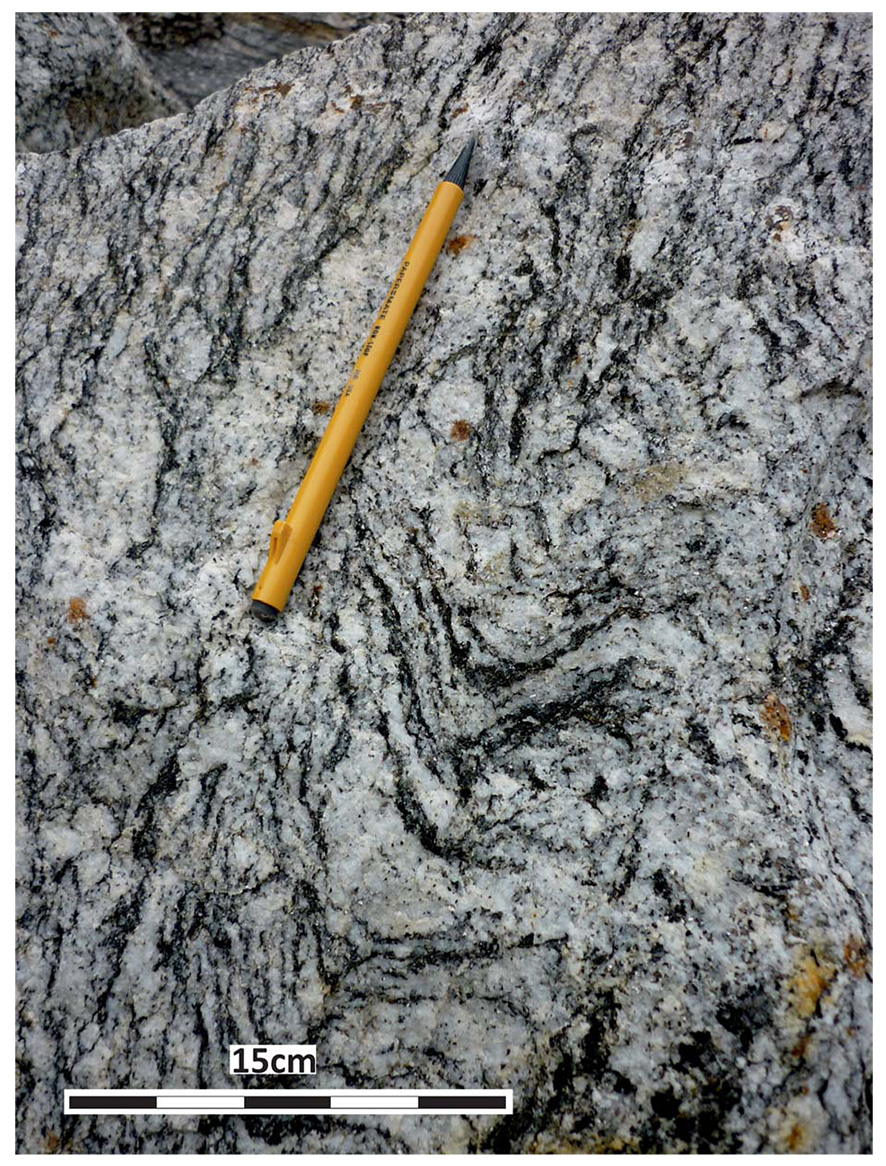
Lingtse gneiss exposed on the roadcut below Tashi viewpoint. The metamorphosed 1.8 Ga granite is deformed and folded by movement on the MCT
3.2 Seven Sisters waterfall (N 27.44115˚, E 88.61030˚)
As the road twists north from the Tashi viewpoint at the outskirts of Gangtok, it travels predominantly through more Lingtse orthogneiss as described at the previous locality. The Seven Sisters waterfall cuts through this extended body of Lingtse gneiss and is similar to location 3.1. Only a few meters from the waterfall, along the road towards Mangan, there is an inferred contact between the Lingtse gneiss and the surrounding schists of the MCT zone. Although it has been suggested that there is a thrust contact between the Lingtse gneiss and surrounding ‘country rock’ (Bhattacharyya and Mitra 2011), shearing associated with the MCT, along with the poor exposure, largely obscures the contact between these rocks which is mainly considered to be an intrusive relationship (Dasgupta et al., 2009; Mottram et al., 2014). The Daling schists which outcrop at Seven Sisters waterfall are kyanite grade and contain virtually pristine examples of euhedral staurolite and kyanite in the garnet + staurolite + kyanite + biotite + muscovite + quartz + plagioclase assemblage (Figs. 3.3 and 3.4c,d). The schists are strongly sheared and have a well-developed schistose foliation which strikes roughly NW-SE, parallel to the trend of the MCT (Figure 3.1). These rocks experienced metamorphic conditions of ~650 °C and ~8-10 kbar which is equivalent to ~20 km depth in the crust (Mottram, 2014).
Figure 3.3. Garnet-staurolite-kyanite schist
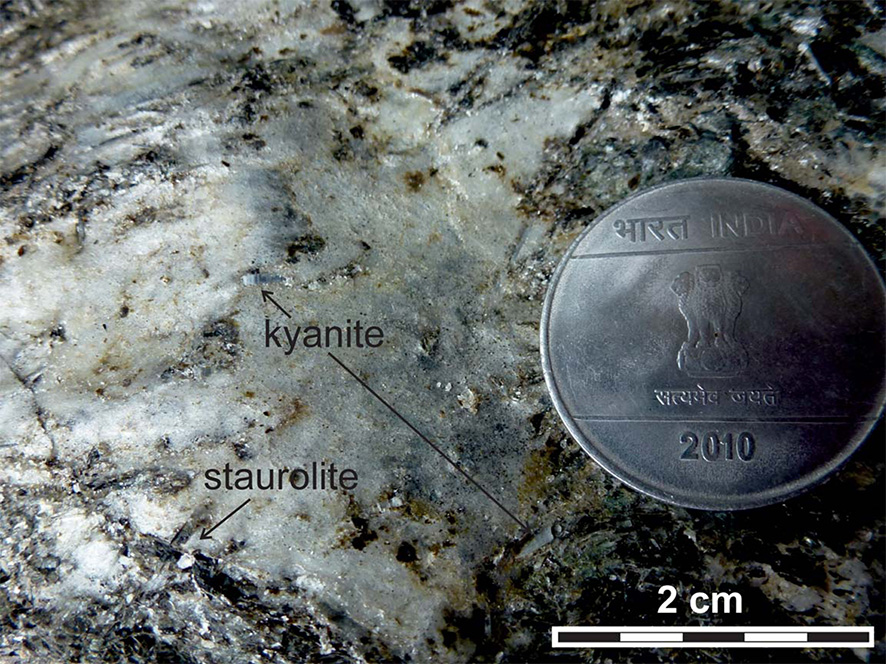
Hand specimen photograph of garnet-staurolite-kyanite schist exposed adjacent to the Lingtse gniess at Seven Sisters waterfall
Figure 3.4. Photomicrographs of thin sections of samples from the Gangtok-Mangan section
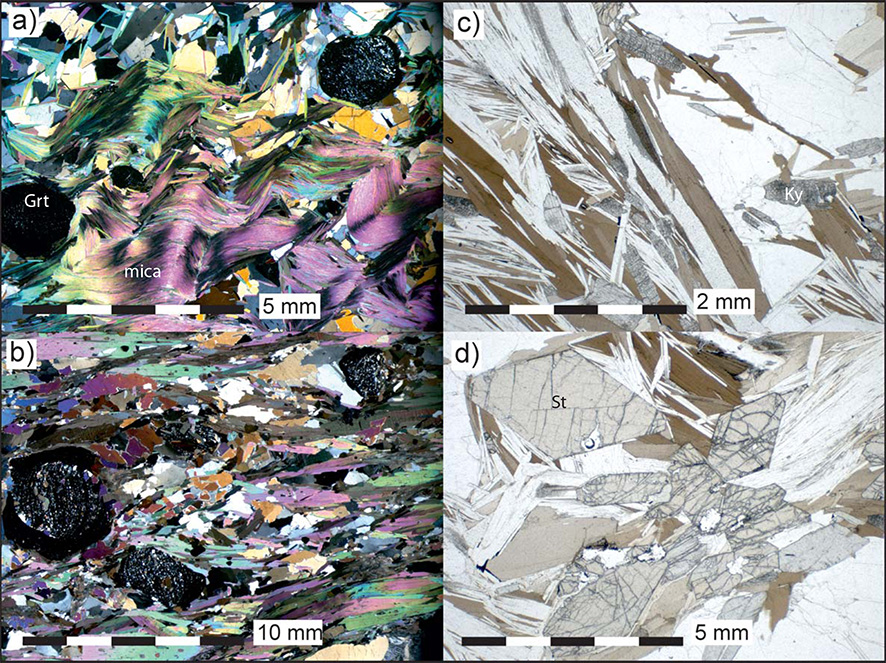
a) Crenulated garnet-mica schist at Singhik shown in cross polarised light (XPL). b) Large garnets (Grt) displaying very strong zoning with syn-kinematic inclusion trails within the garnet core, surrounded by an inclusion free rim at Singhik (XPL). c-d) kyanite (Ky) and euhedral staurolite (St) crystals within a garnet-staurolite-kyanite schist at Seven Sisters waterfall (stop 3.2) shown in plane polarised light (PPL)
3.3 Rang Rang (N 27.46597˚, E 88.52455˚)
The next stop on the virtual fieldtrip is Rang Rang. Many new road cuts in this area have exposed a stretch of ~2 km of rock which exhibits key structural features of the rocks in the MCT zone. Firstly, the fine-grained micaceous schist has large, perfectly euhedral garnet porphyroblasts (Fig. 3.5), which formed syn-to-post kinematically during MCT shearing. Secondly, shear bands are clearly formed in the fine micaceous phyllitic schist, demonstrating the top-to-the-south sense of shear that is prevalent throughout the MCT
The stretch of road between localities 3.3 and 3.4 is a very good example of the inverted Barrovian metamorphic sequence seen as a wide zone beneath the MCT in Sikkim. The road twists in and out of the metamorphic isograds exposing rocks of different metamorphic grade. Between Mangan (close to locality 3.3), Singhik and Manul, there is a series of well-developed mica, garnet-mica, and kyanite-staurolite-garnet mica schist units (Fig. 3.4). These rocks show a strong schistosity striking parallel to the MCT in this area (Fig. 3.1). The dominant MCT deformation is also shown as crenulations (Fig. 3.4a), folds, shear bands and north-south mineral lineations formed along the direction of movement on the MCT. The main micaceous fabric is crenulated at the mm scale. The crenulations are overgrown by syn-metamorp hic garnets and subsequently deformed by shear bands defined by quartz-rich lenses. These fabrics all formed within a ductile regime during a prolonged period of shortening and heating during which the rocks were metamorphosed syn-kinematically (as demonstrated in spiral garnet inclusions in Fig. 3.4b), during Miocene shearing on the MCT zone (Fig. 3.6).
Figure 3.5. Euhedral garnets

Hand specimen photograph of the large euhedral garnets in the fine grained mica schist at Rang Rang
Figure 3.6. Shear bands at Rang Rang
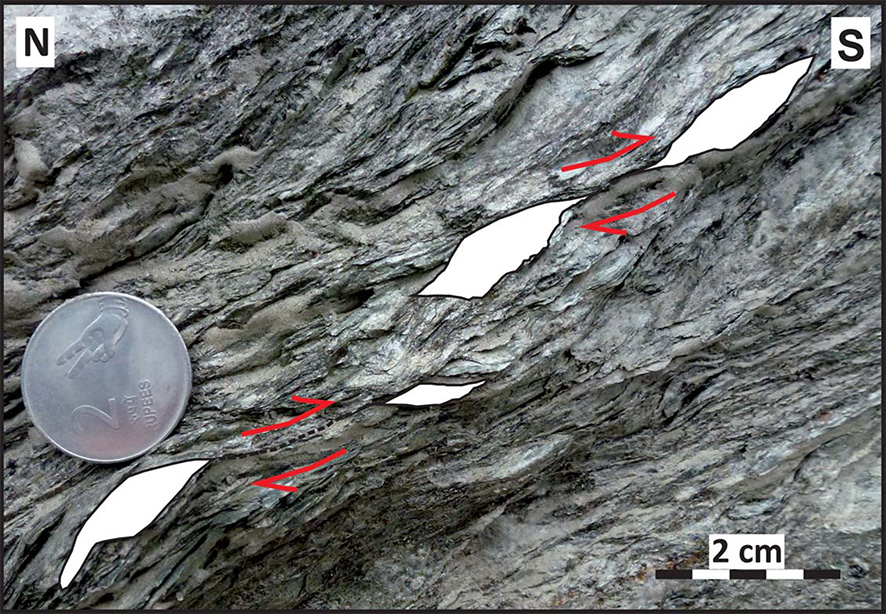
Shear bands are clearly developed in the micaceous schist at Rang Rang showing a top-to-south sense of shear (adapted from Mottram et al., 2014)
Monazite data from this transect demonstrates how the deformation penetrated downward from the structurally higher levels to the lower grade LHS rocks. The kyanite-staurolite schists at the top structural levels yield monazite ages of ca. 15 to 12 Ma, whereas the lower grade mica schist at the lower structural levels yields ages ca. 12-9 Ma (Mottram, 2014), this is in accord with the previous findings of Miocene slip on the MCT in the Sikkim Himalaya (Catlos et al., 2004). Garnet zoning allows for the prograde and peak metamorphic conditions of metamorphism to be calculated, suggesting that the structurally higher grade rocks experienced conditions of around 550 °C and 8-10 kbar during garnet core formation, while the rims formed during peak metamorphism at around 650-675°C and 8-10 kbar during staurolite and kyanite growth. As some samples contain small amounts of fibrolite, it can be inferred that on the retrograde path, rocks passed into the sillimanite field, suggesting isothermal cooling (Mottram, 2014). Overall the data from the inverted metamorphic zone in the Sikkim Himalaya reveals that rocks were metamorphosed during shearing at mid-crustal conditions. Deformation penetrated downwards from the original photolith boundary into the underlying Lesser Himalayan rocks, which became part of the sheared MCT zone.
3.4 Manul (N 27.51440˚, E 88.58273˚)
At Manul, there is a further outcrop of Lingtse gneiss that yields an average 207Pb/206Pb age of 1836 ± 26 Ma (Mottram et al., 2014). The reason this outcrop is particularly notable is due to the intense deformation not seen in the Lingtse outcrops further south. Figure 3.7 demonstrates how the ‘augen’ of the orthogneiss have been strongly stretched into an L-tectonite-type fabric. This locality is a good example of how the strain associated with the MCT deformation is recorded differently depending on the rheology of the rock type. It has been asserted that the location n of the MCT should be based on structural observations and located at the point of highest strain (Searle et al., 2008). This section highlights the difficulty of quantifying strain in the MCT zone and shows why other methods such as geochemical classification are often used to define the location of the MCT.
Figure 3.7. Deformed L-tectonite Lingtse gneiss
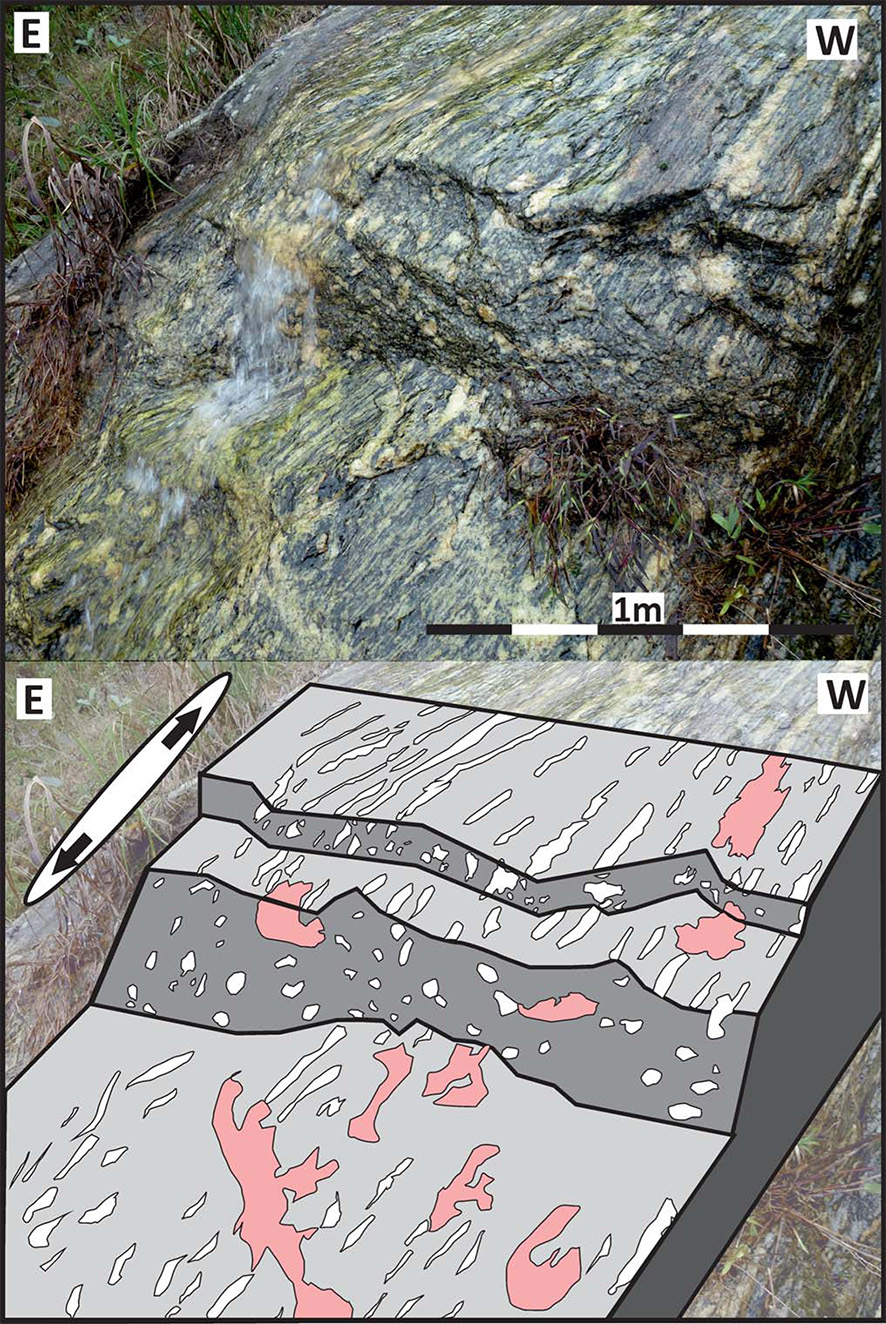
Photograph and sketch of the deformed L-tectonite Lingtse gneiss at Manul (adapted from Mottram et al., 2014)
3.5 Myang (N 27.52737˚, E 88.60660˚)
The Myang fibrolite schist is important as it has a GHS geochemical signature (Mottram et al., 2014), and therefore represents the ‘geochemical’ break associated with the MCT. Myang marks the southern-most boundary of a package of rocks within the MCT-zone that has a GHS geochemical signature and consists of fibrolit ic sillimanite- muscovite schist, calc-silicate, amphibolite and quartzite.
3.6 Toong (N 27.55082˚, E 88.64648˚)
Between Toong and Chungthang the road cuts through a series of high cliffs of calc-silicate, with a spectacular gorge below. The prominent cliffs (Fig. 3.8) are markedly different from anything else seen in the MCT transect. The folded calc-silicate and quartzite which form this section are more resistant to deformation and erosion than the schist that is predominant at structurally lower levels. These rocks have also experienced higher metamorphic conditions
Figure 3.8. Cliffs of folded calc-silicate
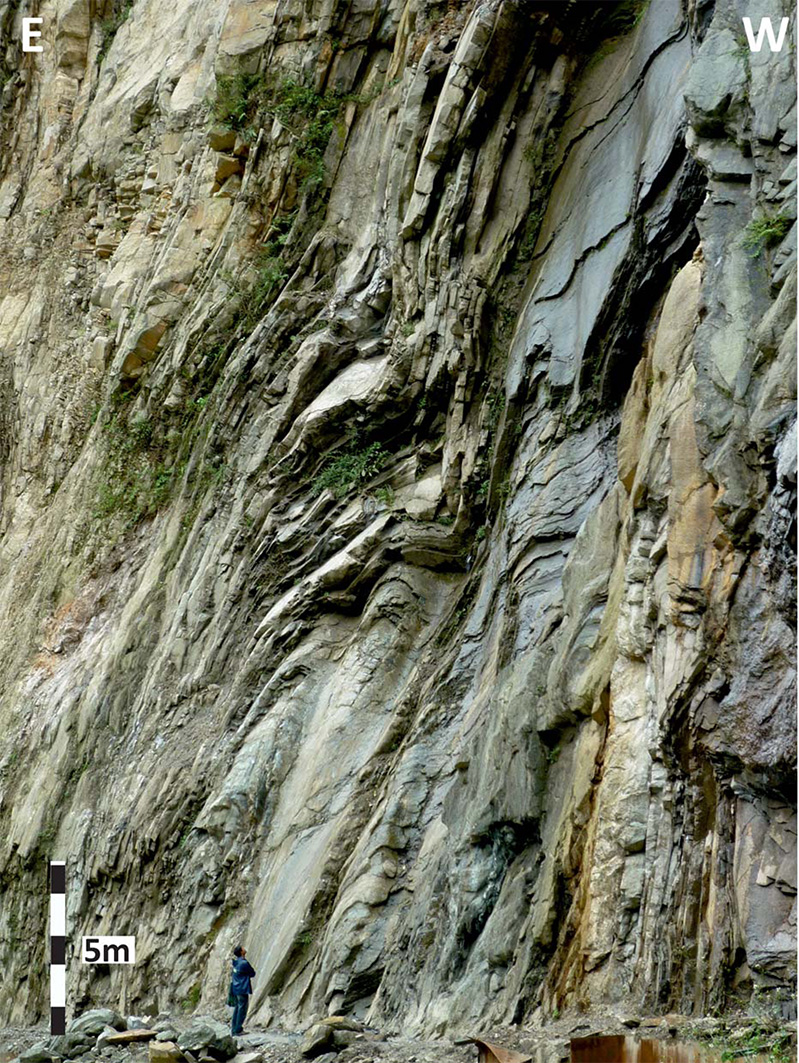
Prominent cliffs of folded calc-silicate to the north of Toong along the road to Chungthang
3.7 Chungthang (N 27.60157˚, E 88.64568˚)
Chungthang marks the northern-most limit of the ‘MCT zone’ in Sikkim. It sits at the confluence of the two rivers that flow from the western Lachen valley and eastern Lachung valley to the north.
The rocks at Chungthang are a complicated mix of quartzite, gneiss, pegmatite and melt veins (Fig. 3.9). The presence of brittle cross-cutting leucosome veins indicates the close proximity to the GHS where related melt most likely originated. The quartzite in this area yields a Paleoproterozoic to Archean detrital zircon signature, indicative of an LHS provenance. It is likely that at the upper levels if the MCT zone, close to the original protolith boundary, rocks of LHS and GHS provenance became interleaved during ductile shearing (Mottram et al., 2014). This may also explain why the rocks to the north of Myang are markedly different from the sections elsewhere in the MCT zone.
